Physical Address
304 North Cardinal St.
Dorchester Center, MA 02124
The primary purpose of gynecologic exfoliative cytology remains the detection of cervical carcinoma and its precursor lesions. Although gynecologic cytology may detect significant endometrial disease, screening for endometrial disease using gynecologic cytology is not appropriate. Direct endometrial cytology may be used to detect endometrial neoplasia. Both endometrial and extrauterine tumors may be detected using cervicovaginal (CV) exfoliative cytologic and direct endometrial sampling. Endometrial cytology has a very limited role in assessing normal endometrial physiologic and hormonal response. Interpretation of endometrium in both exfoliative cytology and direct sampling requires an understanding of the variable morphology of normal, physiologic endometrium.
The endometrium, the lining of the body of the uterus, is composed of numerous glands embedded within a supportive stroma. During a woman's reproductive years the superficial portion of the endometrium, the endometrium functionalis, moves through cycles of proliferation and secretion, followed by desquamation during the menstrual phase, in the absence of any ovum implantation. All of these changes are dependent upon a normally functioning pituitary–ovarian axis. The deeper endometrium basalis, abutting the myometrium, lacks these physiologic phases and serves to regenerate the endometrium functionalis after each menses.
In the proliferative (or follicular) phase, both the endometrial glands and stroma proliferate in response to the rising estrogen levels of ovarian follicular origin. The thickness of the endometrium increases. The glands become increasingly tortuous, and are lined by a tall, pseudostratified columnar epithelium ( Fig. 10-1 ). The cytologic appearance of proliferative glands is very “active,” and characterized by a moderately high nuclear to cytoplasmic ratio, abundant mitotic activity, and prominent nucleoli. The progesterone surge of ovulation ends the proliferative phase, and the endometrium moves into the secretory (or luteal) phase of development. Under normal conditions, the secretory phase is 14 days in length, and the endometrium moves through an orderly sequence of morphologic changes ( Fig. 10-2 ). Under the influence of local autocrine factors, the secretory endometrium disintegrates and collapses. The resultant menstrual endometrium is characterized by cellular, whorls of endometrial stroma exhibiting nuclear debris (“blue balls”), often with overlying, draping epithelium ( Fig. 10-3 ).
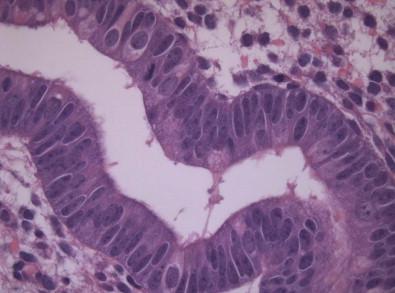
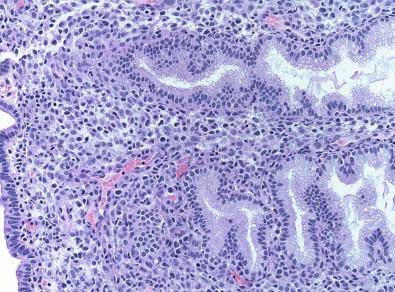
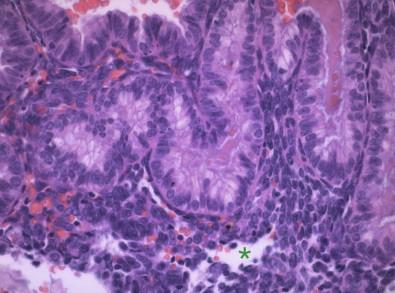
This is the period in the late reproductive years characterized by the transition from reproductive years to the non-reproductive stage. Anovulation occurs with increasing frequency, leading to periods of sustained estrogen production by ovarian follicles. This environment leads to persistent endometrial proliferation without any subsequent secretory phase. Commonly, this hyperproliferative endometrium will undergo stromal collapse and breakdown, producing irregular and abnormal uterine bleeding.
With the exhaustion of ovarian follicles the reproductive years and endometrial cycling ceases. Clinically, menopause indicates the final menstrual period, and is considered to have occurred when there has been no vaginal bleeding for a minimum of 6 months. Endometrial proliferative activity may continue for some months or years, but, in established menopause, the endometrium lacks both proliferative and secretory activity, and is thin and inactive or atrophic. Such endometrium, however, can still be the origin of malignancy.
Numerous types of benign and malignant neoplasms may arise in the body of the uterus and some are detectable in cytologic specimens ( Box 10-1 ). Of these many types, carcinoma is the most common malignancy involving the endometrium, and is the fourth or fifth most common malignancy overall in women in developed countries. Most endometrial carcinomas occur in the postmenopausal woman, although a significant proportion do present in the pre- and perimenopausal woman.
Endometrial carcinoma
Endometrioid adenocarcinoma (and variants)
Mucinous adenocarcinoma
Serous adenocarcinoma
Clear cell adenocarcinoma
Mixed carcinomas
Rare types – squamous, transitional, small cell, undifferentiated
Mesenchymal
Endometrial stromal nodule (benign)
Endometrial stromal sarcoma (low grade and undifferentiated)
Leiomyoma (benign), with growth and histologic variants.
Leiomyosarcoma
Rare types – perivascular epithelioid cell tumour, adenomatoid
Mixed epithelial and mesenchymal
Adenofibroma and adenomyoma (benign)
Carcinosarcoma (or malignant mixed Müllerian tumor)
Adenosarcoma
Gestational trophoblastic disease
Hydatidiform mole, choriocarcinoma, and trophoblastic tumors
Metastatic tumors and lymphoma and miscellaneous
Endometrial carcinomas have been divided into two groups, based upon their histopathologic appearance, immunophenotype, pathogenesis, and recognized precursor lesions. This concept of two types of endometrial carcinoma almost certainly represents an oversimplification of a complex, neoplastic process, but has become very important in disease classification and treatment.
The endometrioid and mucinous adenocarcinomas typify type I carcinomas. These carcinomas are usually early stage at presentation, and generally have a good outcome. An associated endometrial precursor lesion, complex hyperplasia with cytologic atypia, is frequently identified. Such carcinomas frequently arise in a woman with an identifiable hyperestrogenic state. In the postmenopausal woman type I carcinomas are often associated with obesity, which produces an elevated estrogen environment through the peripheral conversion of androgens to estrogens within the peripheral adipose organ, or estrogen-producing ovarian tumors.
The serous and clear cell adenocarcinomas typify type II carcinomas. These carcinomas are aggressive tumors that often show deep myometrial involvement, invade lymphovascular spaces, and exhibit both nodal and peritoneal metastases. In comparison to their type I counterpart, type II carcinomas are responsible for a disproportionately large number of endometrial cancer deaths. Intraepithelial carcinoma of serous and clear types are considered to be the precursor lesion. Estrogenic states do not predispose to the development of type II carcinoma.
The separation of endometrial carcinoma into two distinct diseases can lead to diagnostic challenges in some cases. For example, some endometrial carcinomas showed a mixed type I and II morphology. In addition, poorly differentiated endometrioid adenocarcinomas (type I) show significant overlap in both cytologic features and behavior with type II adenocarcinomas.
Molecular genetic studies of endometrial adenocarcinoma are still evolving but have served to confirm the division of endometrial carcinoma into types I and II. Type I carcinomas (endometrioid subtype) are characterized by early derangements in phosphatase and tensin homolog (PTEN), alterations in the DNA mismatch repair system, activation of the P1K3CA oncogene, and early mutations in the K-ras proto-oncogene. The tumor suppressor gene p53 may have a role in the progression of type I carcinomas, but not in their initiation. The most frequently altered gene, PTEN, is a tumor suppressor gene involved in signal transduction of cell growth and apoptosis, and is activated not only in up to one-half of type I carcinomas, but also in a proportion of both atypical and non-atypical endometrial hyperplasias and plays an important role in the development of hyperplasia. Mutations in P1K3CA are more common in cases with PTEN mutations, but are rare in complex atypical hyperplasia and may play a role in transformation of complex atypical hyperplasia to carcinoma.
In contrast, the p53 tumor suppressor gene is altered in the vast majority of type II carcinomas, as well as their precursor lesion, endometrial intraepithelial carcinoma. The marked, diffuse immunohistochemical staining for p53 protein can be used to confirm the histopathologic diagnosis of type II carcinomas, although it may also be identified in grade 3 endometrioid adenocarcinomas and is more of an indicator of tumors which behave aggressively rather than a specific marker for serous differentiation. Some type II carcinomas may have mutations in P1K3CA as well.
Endometrial carcinoma is one of the most common cancers in women living in developed countries. In 2012, endometrial cancer was the fourth most common cancer of Canadian women (after breast, lung, and colorectal), and composed about 6% of all new cancer cases. Since most women with endometrial carcinoma present with early stage disease, however, the case fatality rate is lower than that in many other cancer sites. Consequently, the mortality rate from endometrial carcinoma ranked eighth in comparison with other tumoral sites.
The clinical presentation of types I and II carcinomas are often different. About 80–90% of all endometrial carcinomas are type I. Women with type I carcinoma are usually premenopausal, perimenopausal, or early postmenopausal. Chronic anovulation in the reproductive aged women, a state resulting in sustained estrogen stimulation, is associated with an increased risk of type I carcinoma in this age group. Other risk factors for the development of type I carcinomas are obesity, diabetes mellitus, and hypertension. Estrogen administration unopposed by the use of progestins in the postmenopausal woman is associated with the development of type I carcinomas. In contrast, the woman with type II endometrial carcinoma is usually elderly and late menopausal. Frequently, these women are not obese, diabetic, or hypertensive.
Endometrial carcinomas may present as either a focal, polypoid tumoral mass or as an irregular thickening of the endometrium. Abnormal vaginal bleeding and discharge, the usual presenting symptoms, are results of tumoral necrosis and breakdown. As the tumor advances the endometrium is replaced by a diffuse carpet of friable tumor. The carcinoma will penetrate into the myometrium and cervix. With access to lymphatic spaces spread to regional (pelvic) lymph nodes will occur. Spread through the fallopian tube to the peritoneum is another source of metastatic disease and is common in type II carcinomas. Advanced cases of endometrial carcinoma are characterized by hematogenous spread to more distant sites. The “stage” of a tumor is the extent of spread of the carcinoma at presentation, and is a key determinant of both prognosis and management ( Table 10-1 ). Since 1988, endometrial carcinoma has been staged using surgical pathology parameters ( Table 10-1 ).
| Stage 1 | No or less than half myometrial invasion (stage 1a) |
| Invasion equal to or more than half of the myometrium (stage 1b) | |
| Stage 2 | Tumor invades the cervical stroma, but does not extend beyond uterus |
| Stage 3 | Tumor invades uterine serosa and/or adnexae (stage 3a) |
| Vaginal and/or parametrial involvement (stage 3b) | |
| Metastases to pelvic lymph nodes (stage 3ci) | |
| Metastases to para-aortic lymph nodes (stage 3cii) | |
| Stage 4 | Tumor invades bladder and/or bowel mucosa (stage 4a) |
| Distant metastases, including intra-abdominal (stage 4b) |
In the 1988 revision of the International Federation of Obstetricians and Gynecologists (FIGO) Staging System for endometrial carcinoma, the finding of positive peritoneal cytology led to a FIGO stage 3ai. However, stage 3 was a heterogeneous group of carcinomas with respect to both pathologic findings and prognosis. Stage 3aii was defined by tumoral involvement of the uterine serosa or adnexae, stage 3b by vaginal metastasis, and stage3c by metastasis to pelvic or para-aortic lymph nodes. Not only were the outcomes of these four groups very different, the management of stage 3ai was highly variable. Subsequently, in the 2009 revision of FIGO staging, positive peritoneal cytology was removed as a defining characteristic for any FIGO stage. Nevertheless, since there continues to be controversy whether a positive peritoneal washing is an independent adverse risk factor, particularly in low-stage disease, peritoneal washings may still be obtained. Overall, about 11% of endometrial carcinoma patients have positive peritoneal cytology.
Both types I and II endometrial carcinomas exhibit columnar cell or glandular differentiation, and are thus designated as adenocarcinomas. Rarely, squamous and undifferentiated carcinomas may occur ( Box 10-1 ). In both types I and II adenocarcinomas the normal glandular architecture of the endometrium is lost, and the glands show architectural complexity with intraglandular bridging and epithelial stratification ( Fig. 10-4 ). This proliferation of abnormal glands results in a back-to-back pattern with minimal stroma. The stroma loses its normal endometrial appearance, and acquires a fibrotic (desmoplastic) appearance. Areas of the adenocarcinoma often undergo necrosis. Necrotic debris may be evident in gland lumina. The malignant epithelial cells are larger than normal; their shape may be columnar, cuboidal, polygonal, or round. The amount of cytoplasm is variable. Often the cellular polarity within the gland lining is lost. The large nuclei are round or oval, and have an abnormal chromatin pattern. Mitotic activity is evident.
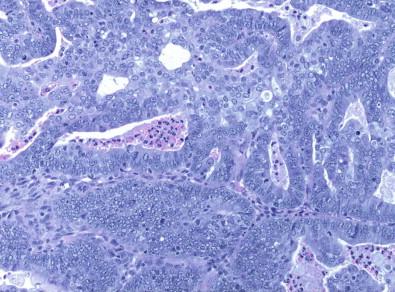
A number of architectural and cytologic features are used to differentiate type I from type II adenocarcinomas. The malignant glands of type I (endometrioid) adenocarcinomas retain a resemblance to the proliferative glands of normal endometrium with tall basophilic lining epithelium ( Fig. 10-4 ). Variable amounts of squamous differentiation, previously called “metaplasia,” are present. Elongated, slender papillae of adenocarcinoma (“villoglandular”) lined by stratified columnar epithelium with pencil-shaped nuclei are common. In contrast, the lumina of the malignant glands of type II (serous and clear cell) adenocarcinomas show numerous internal papillae, many of which consist of epithelium only. These papillae crowd into the lumen, leaving only residual slit-like spaces ( Fig. 10-5 ). Papillary fronds of adenocarcinoma with a distinct central vascular connective tissue stalk are common. Psammoma bodies may, or may not, be present. In some cases, solid sheets or trabeculae may predominate. There is striking nuclear atypia of the lining epithelium, often characterized by an open chromatin pattern with a large nucleolus. Clear cell carcinomas share these features, but, in addition, the cytoplasm is clear rather than the basophilic or eosinophilic cytoplasm of serous carcinoma as a result of the accumulation of glycogen ( Fig. 10-6 ).
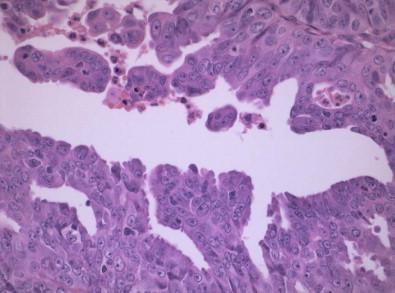
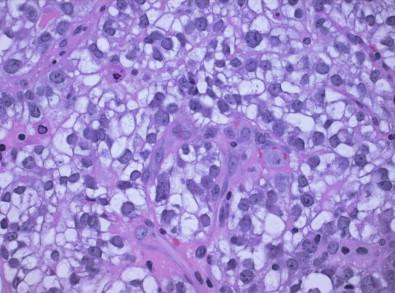
The grade of an endometrioid adenocarcinoma is an important determinant of management. The FIGO system for evaluating and classifying the grade of an endometrioid adenocarcinoma is the most widely used system ( Table 10-2 ). This grading system is not used for type II adenocarcinomas, since all of these tumors are high-grade neoplasms.
| Grade 1 | ≤5% non-squamous solid growth pattern |
| Grade 2 | 6–50% non-squamous solid growth pattern |
| Grade 3 | >50% non-squamous solid growth pattern |
| Notable nuclear atypia inappropriate for the architectural grade of the carcinoma raises the grade of otherwise grade 1 carcinomas by 1 level. | |
| If mucinous adenocarcinomas are graded using these criteria most are grade 1. | |
Although endometrioid differentiation is the most common histologic pattern within the type I group of tumors, other routes of differentiation, including mucinous, secretory, and ciliated patterns, may occur. When these non-endometrioid patterns predominate, a specific designation is used for these adenocarcinomas ( Box 10-1 ). When these other patterns are present in a smaller amount, yet still compose at least 10% of the adenocarcinoma, then the designation of a “mixed adenocarcinoma” is appropriate. Well-differentiated endometrioid adenocarcinomas exhibiting an extensive benign-appearing squamous component have previously been labeled as “adenoacanthomas,” whereas poorly differentiated endometrioid adenocarcinomas exhibiting an extensive malignant squamous component were labeled as “adenosquamous carcinomas.” Since these labels led to some confusion in terminology and practice, they have been discarded. Instead, the term “endometrioid adenocarcinoma with squamous differentiation” is preferred with an accompanying statement specifying the grade.
Cells from the endometrial cavity can be retrieved and examined using either exfoliative CV cytology or direct uterine sampling.
Although the primary purpose CV cytology remains the detection of cervical carcinoma and its precursor lesions, exfoliative cytology also reflects the physiologic state of the cyclic endometrium and some of its abnormalities. Spontaneously shed endometrial cells are part of the normal cellular sample obtained by exfoliative cytology for cervical screening. Such shedding typically occurs during the menstrual cycle or in the first part of the proliferative phase. Abnormally shed endometrial cells from endometrial neoplasms can be apparent and may provide an opportunity for diagnosing significant endometrial pathology. Three different reporting terminologies of normal and abnormal endometrial cells in CV cytology are compared in Table 10-3 .
| Cytologic Findings | The Bethesda System, 2001 | British Society for Clinical Cytology, 2000 | Australian Modified Bethesda System, 2004 |
|---|---|---|---|
| Normal endometrial cells – women <40 years | Optional to report | May be disregarded | Should not be reported |
| Normal endometrial cells – women ≥40 years | Other, endometrial cells in women ≥40 years a | Negative, report presence of endometrial cells a | Should not be reported b |
| Atypical endometrial cells | Atypical endometrial cells | Borderline nuclear change, endometrial cells | Atypical glandular cells of undetermined significance Possible high-grade glandular lesion |
| Endometrial adenocarcinoma | Adenocarcinoma, endometrial | ? Glandular neoplasia, endometrial | Adenocarcinoma, endometrial |
a These categories should be accompanied by an educational note detailing the possible significance of this finding. When menstrual history is provided NECs present in the first 12 days of the cycle may be disregarded.
b Symptomatic postmenopausal women require investigation irrespective of the status of their Pap test.
Three cytologic findings in CV cytology have been suggested as indicators of endometrial carcinoma and disease. The hyperestrogenic environment commonly seen in type I carcinomas promotes increased maturation of the squamous epithelium, resulting in a shift to the right in the vaginal maturation index (MI) for a postmenopausal woman. This finding alone, however, is a poor predictor of endometrial carcinoma, since it is frequently found in the absence of endometrial carcinoma. For example, both systemic drug and local treatment can lead to this MI shift. A second cytologic finding, histiocytic exodus, has also been suggested as a useful predictor of endometrial neoplasia, since a stromal infiltrate of histiocytic-type cells is frequently seen in both endometrial hyperplasia and neoplasia. Although initial studies of histiocytic number and exudate in postmenopausal women suggested that this finding did indeed have utility in detecting endometrial carcinoma, subsequent analyses have concluded that this finding is too nonspecific to be useful. Thus, with exclusion of both MI and histiocytic exodus as useful predictors the detection of endometrial carcinoma in CV cytology is dependent upon the presence of cytologically abnormal or normal endometrial cells. Reports on the prevalence of such endometrial cells in CV cytology in cases of endometrial carcinoma have been quite variable. Some studies have found that only a minority of endometrial carcinomas exhibit endometrial cells, whereas others have reported that most endometrial carcinomas are detectable by CV cytology. Retrospective rescreening of Papanicolaou (Pap) tests from women with endometrial carcinoma has revealed screening and interpretive false-negative cases in a large proportion. Endometrial carcinomas which have detectable malignant cells in CV cytology are more likely to be high grade and higher stage. The variable, and low, sensitivity of CV cytology in detecting endometrial carcinoma precludes its use as a screening tool for this disease.
There is evidence to suggest that liquid-based cytology (LBC) is more sensitive than conventional cytology in detecting endometrial adenocarcinoma. The superior performance of LBC has been attributed to the more consistent and optimal presentation of endometrial cells as compared to that in conventional cytology. In one study, the positive predictive values for endometrial adenocarcinoma and atypical endometrial cells in one LBC preparation was superior to those of historical conventional Pap smears.
A recently developed technique analyses residual liquid-based Pap test material for DNA somatic mutations which may be present in exfoliated endometrial or ovarian tumour cells. The results have not been validated in larger studies and are not yet available for clinical use. However, in this study, all 24 endometrial cancers and 41% of ovarian cancers were detected by the DNA analysis of the liquid-based Pap test material.
Direct sampling of the endometrial cavity can occur using two methods. Aggressive endocervical sampling can reach the lower uterine segment (LUS) and retrieve cells and fragments from this region. In addition, many proprietary endometrial sampling devices for procuring endometrial cells have been developed. Most of these devices use elongated brushes that can be passed through the endocervical canal to reach the endometrial cavity. The addition of a protective sheath to minimize contamination from the exo- and endocervix has improved the diagnostic accuracy that can be achieved. After the cells are procured, the sample can be smeared on a slide or placed into liquid fixation. Most commonly, the sample is fixed in a liquid medium and prepared using centrifugation or filter techniques. Tissue fragments can be filtered to produce cell blocks, and multiple slides can be prepared for both regular and immunocytochemical stains. The sampling devices are reported to be easy to use, are well accepted by patients, cause less discomfort than histologic biopsy, and yield fewer non-diagnostic specimens than endometrial biopsy.
Direct cytologic sampling of the endometrial cavity has been reported to be capable of detecting endometrial carcinoma with high (>90%) sensitivity, particularly if atypical findings are considered positive results. However, there has not been widespread adoption of endometrial cytology in clinical practice as either a diagnostic or screening tool, at least in North America and Western Europe, principally for three reasons. First, reporting of “suspicious” or “atypical” has led to a high rate of nonspecificity, often necessitating additional invasive procedures for assessment. Second, unsatisfactory endometrial sampling is not uncommon. Third, histologic sampling devices are often preferred since they are capable of detecting not only endometrial carcinoma with high sensitivity, but also additional clinically significant endometrial lesions, such as polyps and hyperplasia. These important lesions are not reliably detected by cytologic sampling alone. Some methods combine the use of cell block and histologic preparation to compensate for this inadequacy of stand-alone cytologic techniques.
Direct endometrial cytology may find a role in selective clinical situations. It may be useful as an adjunctive technique to endometrial biopsy and curettage in the assessment of women with abnormal uterine bleeding, but only if laboratories are properly trained to prepare, screen, and diagnose these specimens. It has been proposed that the negative predictive value of direct endometrial sampling is high and that it could be used in the initial assessment of the endometrial cavity in symptomatic women or asymptomatic women with abnormal ultrasound findings. Subsequently, only women with positive results would undergo the more specific test of endometrial biopsy. Fundic and isthmic carcinomas may escape detection in curettage specimens, and subsequent endometrial cytology may be useful. Finally, endometrial biopsy in the outpatient setting may be impossible or inadequate in the very small atrophic uterus, whereas direct endometrial cytology may be acceptable.
Become a Clinical Tree membership for Full access and enjoy Unlimited articles
If you are a member. Log in here